This simple 6 ingredient focaccia dough is a wonderful starting point for many different flavors, including garlic rosemary herb focaccia. The homemade bread is chewy and soft in the center with a mega crisp exterior. For the BEST flavor, let the dough rest in the refrigerator overnight. Olive oil seeps down and infuses every bite. You’ll love it!
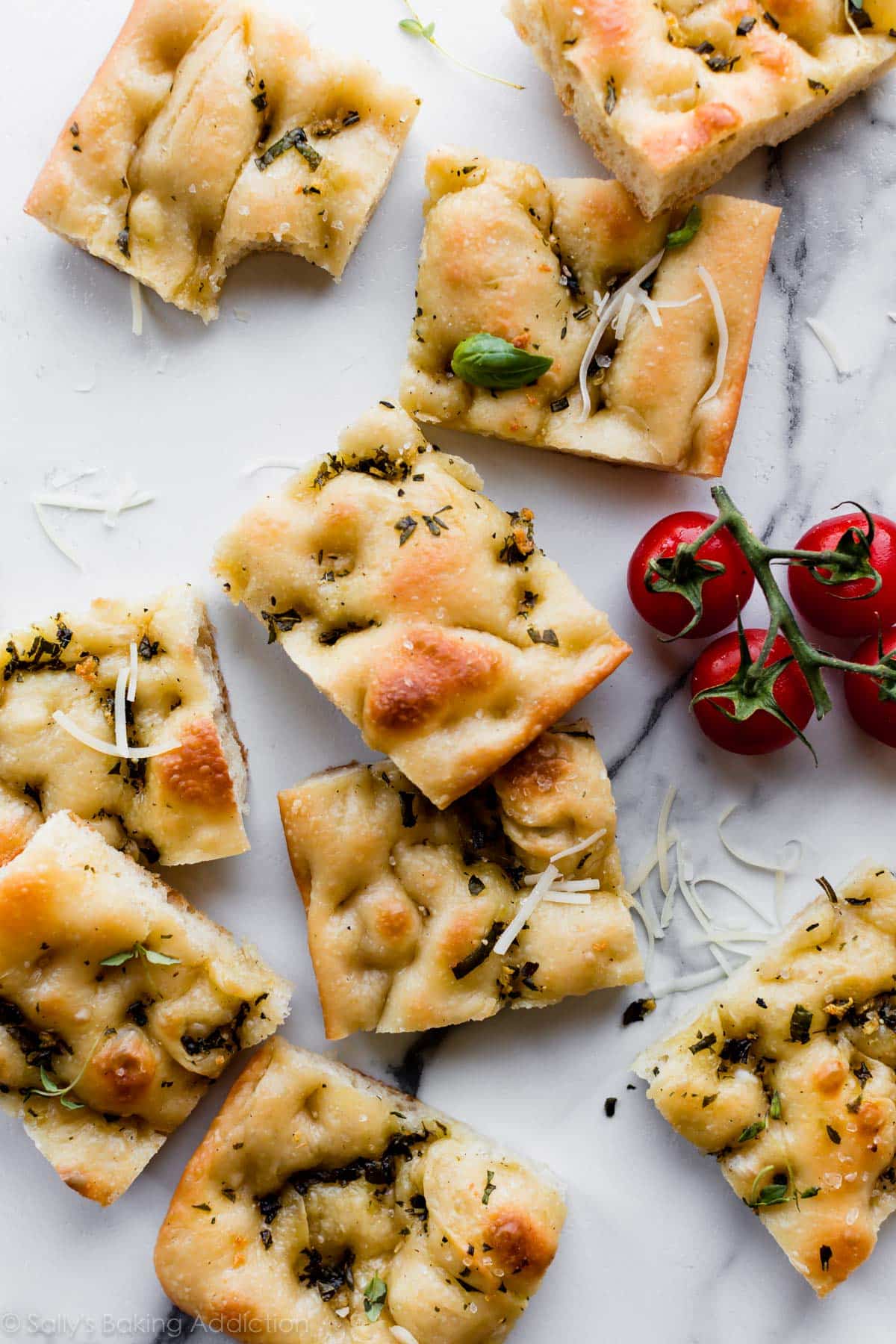
Let’s make focaccia!! I’ve been working on perfecting focaccia for awhile. Focaccia is an Italian yeast bread. At the heart of it, focaccia is pizza dough without the sauce and cheese. Though it appears plain, focaccia is anything but boring. Its defining characteristics are the olive oil infused flavor and deliciously crisp exterior. Olive oil enrobes the entire crust, seeping into the interior as the bread bakes. Herbs and garlic are popular toppings, but you can add anything like olives, tomatoes, sesame seeds, parmesan cheese, pine nuts, pesto, caramelized onions, and more.
Pizza is a meal, but focaccia can be part of a meal, an appetizer, a soup dipper, a sauce soaker-upper, and even the crust of a sandwich or panini. I particularly enjoy serving it in the summer and always include it on my menu of Memorial Day recipes. Regardless of how and when it’s served, this garlic rosemary herb focaccia is remarkably chewy, rich, and flavorful.
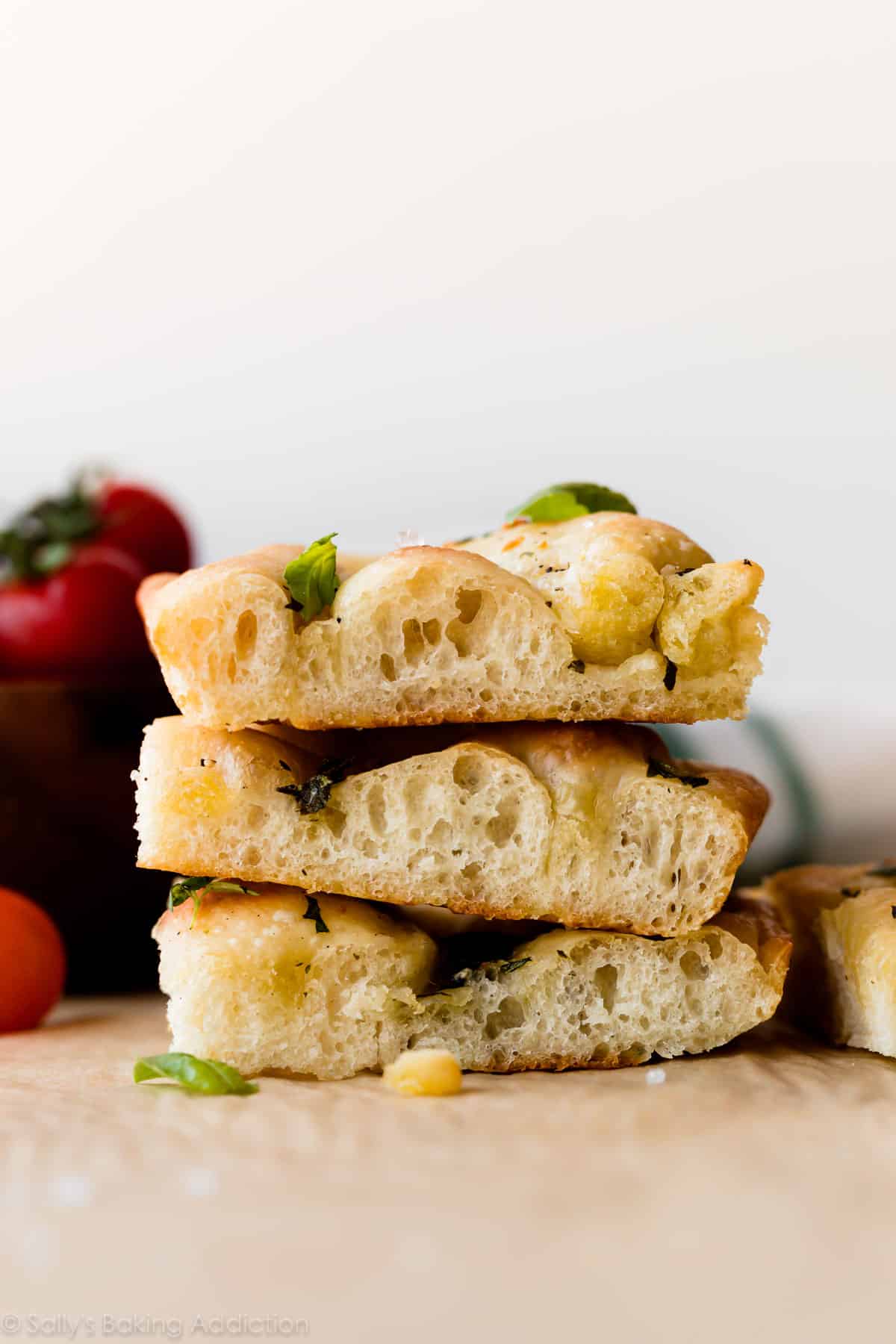
Video Tutorial: Garlic Herb Focaccia
Sit back, relax, and watch as I walk through each step in this garlic rosemary herb focaccia recipe. In fact, most of the “work” is hands-off while the dough rises and rests so you can literally sit back and relax when it’s your turn to make it!
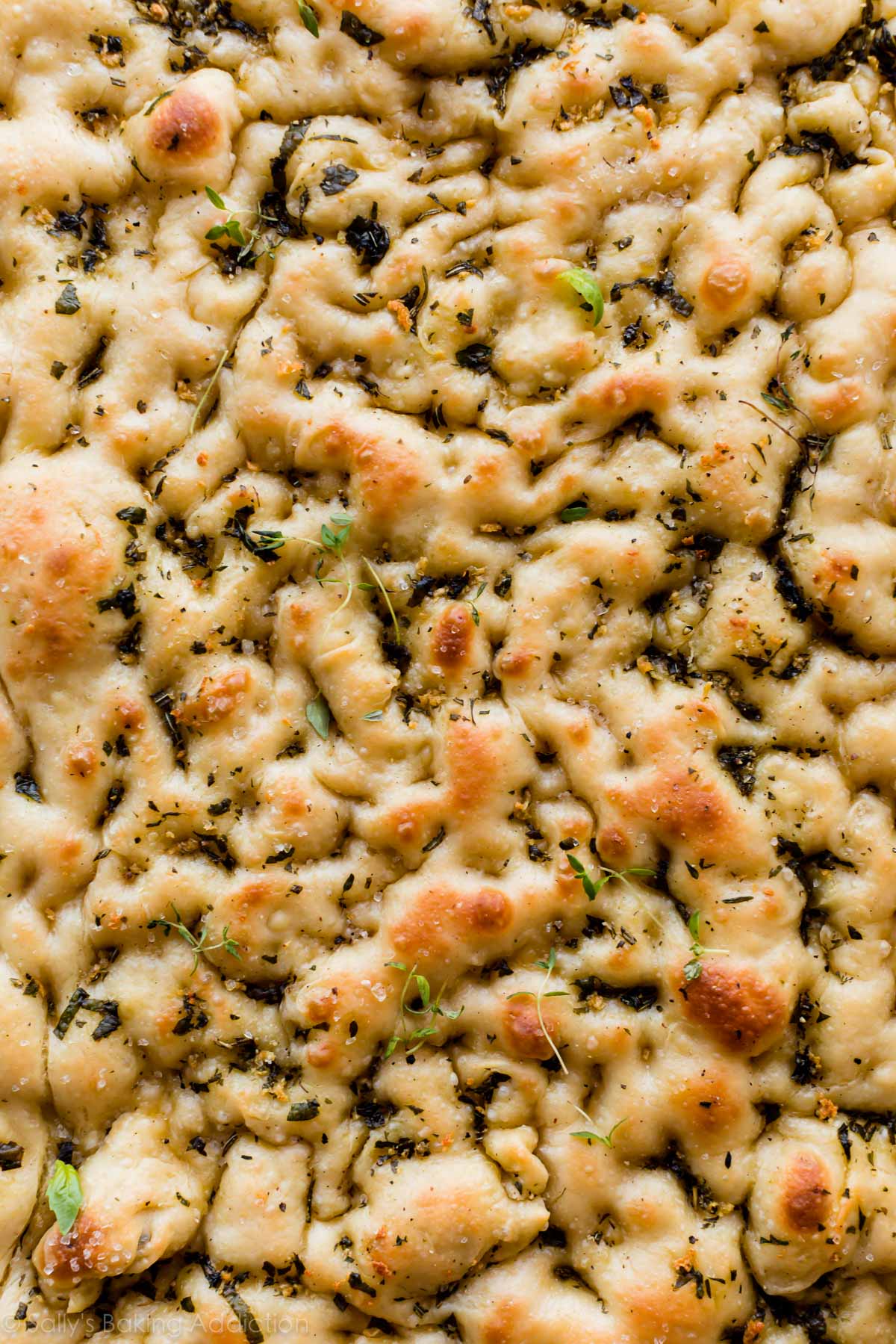
Only 6 Ingredients in Focaccia Dough
Focaccia dough comes together with only 6 basic ingredients. Whether or not you’re a seasoned baker, I bet you have most of these items in your kitchen. This recipe yields a big pan of bread and leftovers freeze wonderfully. (We’ve been snacking on test recipes for weeks now!) If you don’t need that much bread on hand, feel free to halve the recipe.
Let’s quickly discuss the importance of each ingredient.
- Yeast: Yeast raises focaccia bread. If you’re nervous about working with yeast, I encourage you to review my Baking with Yeast guide. You can use active dry or instant yeast. I played around with different amounts and ultimately favored the bread with less yeast than some other recipes call for. The flatter the focaccia, the more the interior is infused with the olive oil and toppings!
- Sugar: 2 teaspoons of sugar feeds the yeast.
- Warm Water: When combined with liquid and sugar, yeast makes dough rise. Use warm water to cut down on rise time, about 100-110°F. Anything over 130ºF kills the yeast.
- Salt: A lot of focaccia’s flavor comes from salt and this dough requires a lot of it. For the best flavor, I strongly recommend using kosher salt.
- Olive Oil: Some recipes only call for olive oil as the topping, but adding olive oil to the dough creates a richer-tasting bread. You’ll also use it to coat the pan and top the dough before baking, just like we do when we make pesto pizza. Use your favorite kind—I prefer extra virgin olive oil.
- Bread Flour or All-Purpose Flour: I tested this focaccia with both and prefer the bread flour variety. Both are great, but bread flour has a higher protein content so it yields a chewier texture. This recipe calls for 4.5–5 cups of flour, and if using bread flour, you’ll need closer to 4.5 cups since it absorbs more water. If using all-purpose flour, you’ll need closer to 5 cups. It all depends on how sticky the dough feels. Adding a bit too much or too little flour won’t ruin the recipe, so don’t be nervous.
Baking with Yeast Guide
Reference this Baking with Yeast Guide whenever you work with baker’s yeast. I include practical answers to all of your common yeast questions!
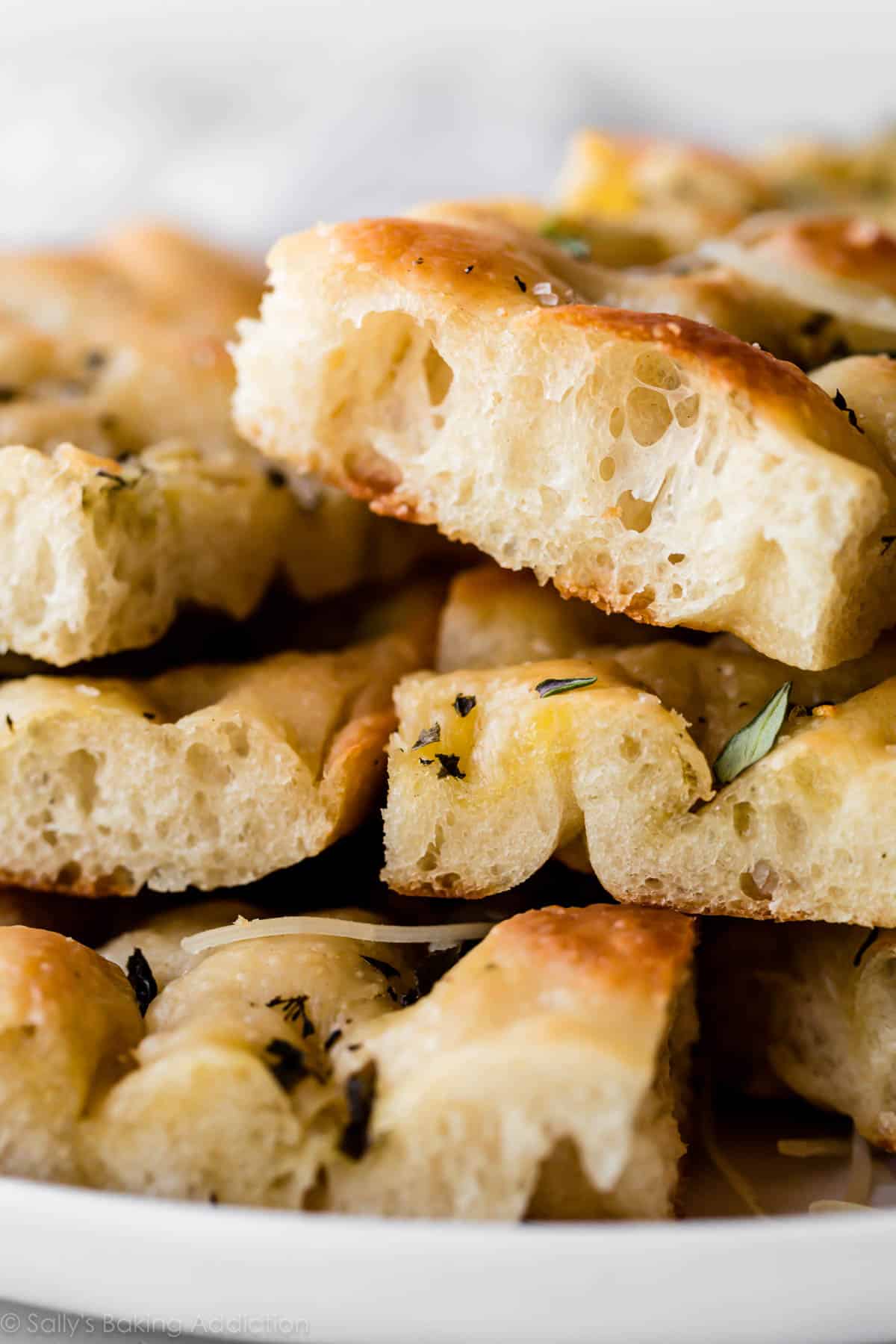
How to Make Garlic Herb Focaccia
Focaccia is a very simple bread. This recipe requires a rise, plus a considerable amount of “resting” in the refrigerator. Most of the dough’s flavor is developed during this cold resting period, so I don’t recommend rushing it. You can’t rush good bread.
- Make the dough: Mix the ingredients together, and then knead the dough by hand or with your mixer. I like doing this by hand and you can watch me in the video, or in my separate How to Knead Dough tutorial.
- Let the dough rise: Place dough into a greased bowl, cover tightly, then set aside to rise for about 2–3 hours.
- Flatten dough out onto a baking pan: Punch down the risen dough to release the air, then use your hands to flatten the dough out onto an oiled baking sheet. If the dough keeps shrinking, cover it for 5 minutes to let the gluten settle.
- Let the dough rest in the refrigerator: The cold temperature slows down the rising. In fact, there’s so little yeast that the dough will hardly rise at all during this step. Let it rest in the refrigerator for as little as 1 hour and up to 24 hours. The longer it rests, the better the flavor. I recommend at least 12 hours, just like with my artisan bread recipe. You won’t regret it!
- Remove from the refrigerator: Let the dough hang out on the counter as you preheat the oven and prep the toppings. It will rise a little bit, but not much.
- Preheat oven: Focaccia bakes in a very hot 450°F (232°C) oven.
- Dimple the dough: A good stress reliever! Use your fingers to dimple the entire surface of the dough just like we do when making cold veggie pizza. The dimples give the olive oil and toppings “a place to go.” This step is fun!
- Add toppings: A simple blend of fresh garlic, rosemary, thyme, and basil is a favorite, but I have plenty of focaccia topping suggestions listed below. No matter which topping you use, drizzle olive oil all over the surface.
- Bake: Bake until golden brown. I set the oven to broil for the last minute to really crisp up the surface. Highly recommended!
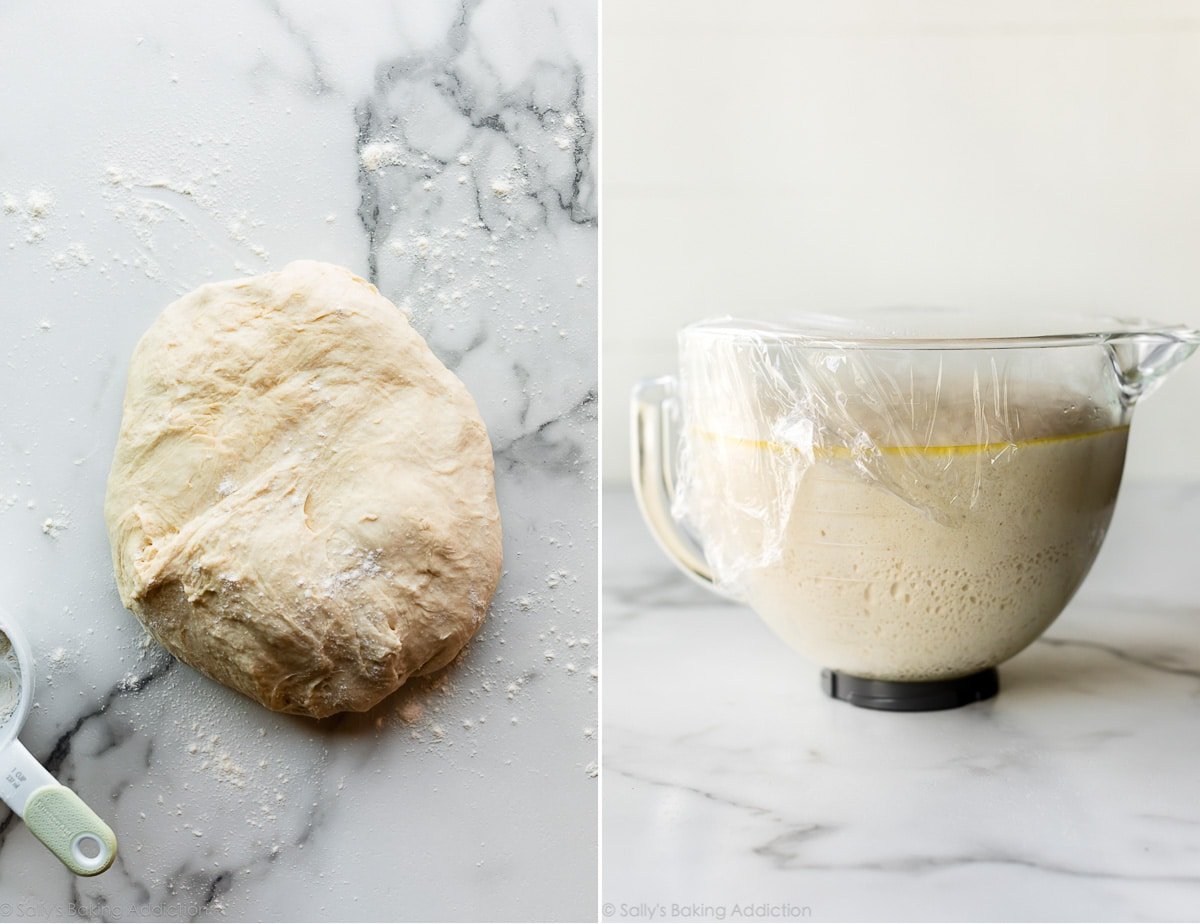
The dough stretches to fit a large baking sheet. You can also divide the dough in half for 2 smaller focaccia loaves. I love that there’s no rolling pin or complicated shaping required.
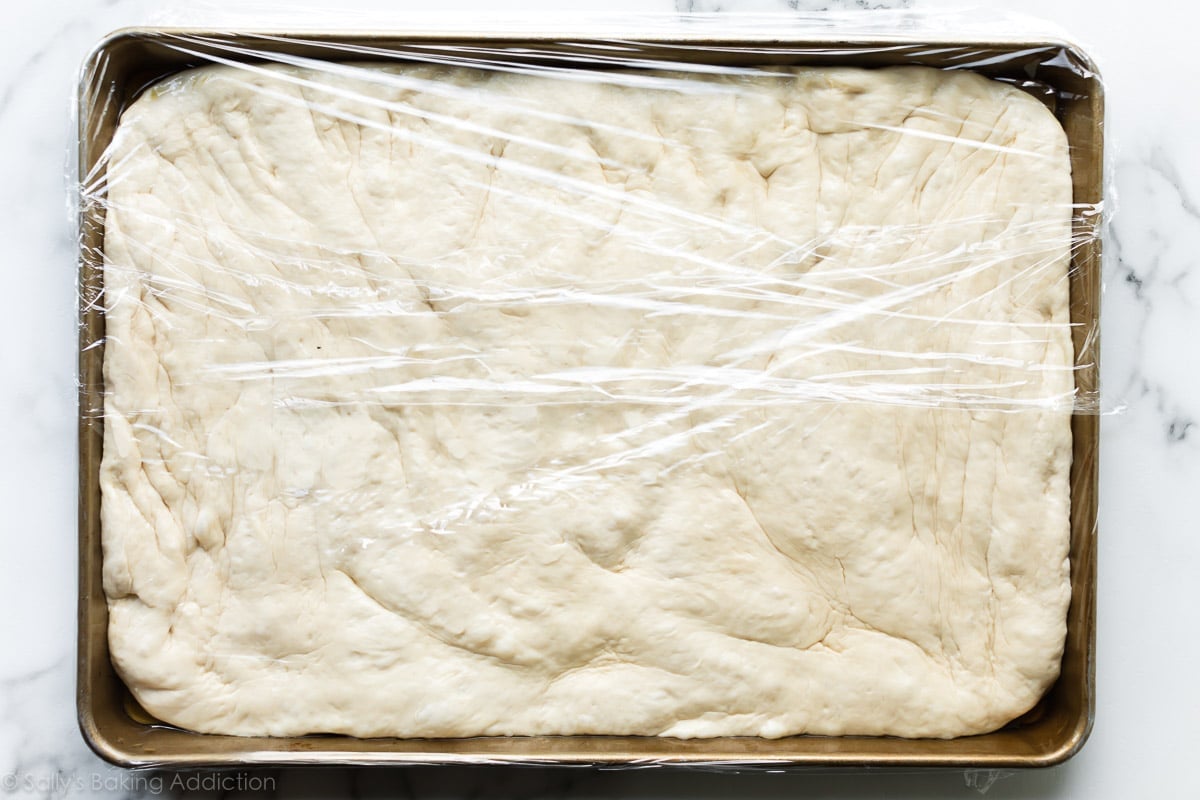
After the dough rests in the refrigerator, dimple it with your fingers, then add toppings:
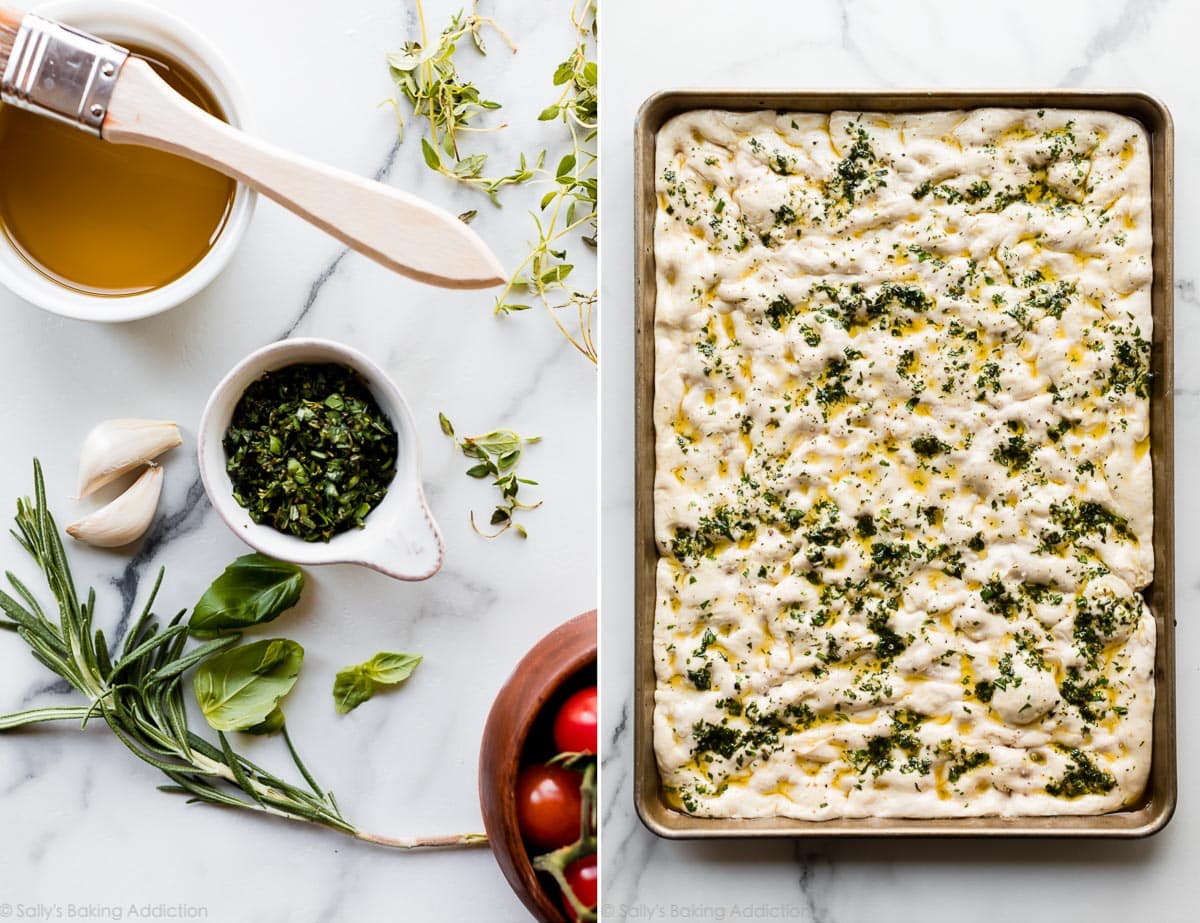
Make Ahead Recipe
As mentioned above, the longer the dough rests, the better it tastes. Focaccia is a convenient make-ahead recipe since you can do most of the work the day before serving. The bread tastes AWESOME warm from the oven, but it lasts all day if you want to bake it several hours prior to serving. Leftovers keep well for a few days or even a few months in the freezer, but some of the crispiness is lost over time. However, a few minutes in a preheated oven quickly brings leftover focaccia back to life!
Freezing dough: You can also freeze focaccia dough just as you would freeze pizza dough. After the dough rises in the mixing bowl, punch it down to release the air, coat it with a little olive oil, then cover and freeze for up to 3 months. Thaw in the refrigerator. Once thawed, remove the dough from the refrigerator and allow to rest for 30 minutes on the counter. Finally, shape the dough on the baking sheet and continue with the recipe.
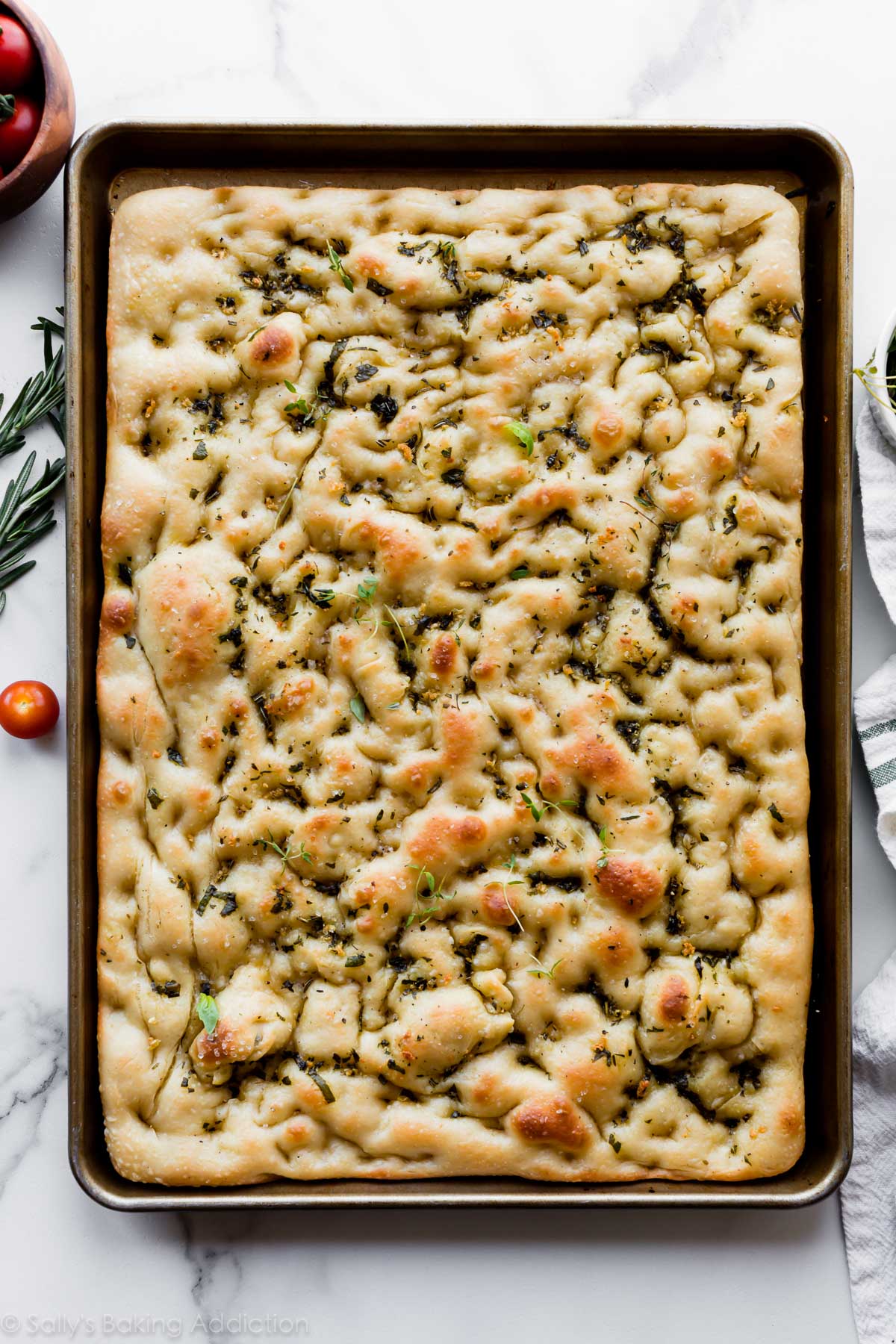
Focaccia Toppings
Garlic & rosemary herb focaccia is a classic favorite, but you can customize it with various toppings. There’s truly no limit and here’s a list to prove it. Leave out the garlic and herbs (or keep them!), drizzle the dough with the olive oil, then add any of these toppings:
- Everything Bagel Seasoning
- Cherry Tomatoes or Sliced Tomatoes
- Parmesan (add before or after baking)
- Pesto (add before or after baking)
- Sliced Zucchini
- Pine Nuts
- Sliced Lemons or Lemon Zest
- Sun-Dried Tomatoes
- Olives
- Mushrooms
- Artichokes
- Raw or Caramelized Onions
I topped a test batch with the garlic & herb olive oil called for in the recipe below, plus some pine nuts and thinly sliced tomatoes. We all DEVOURED it.
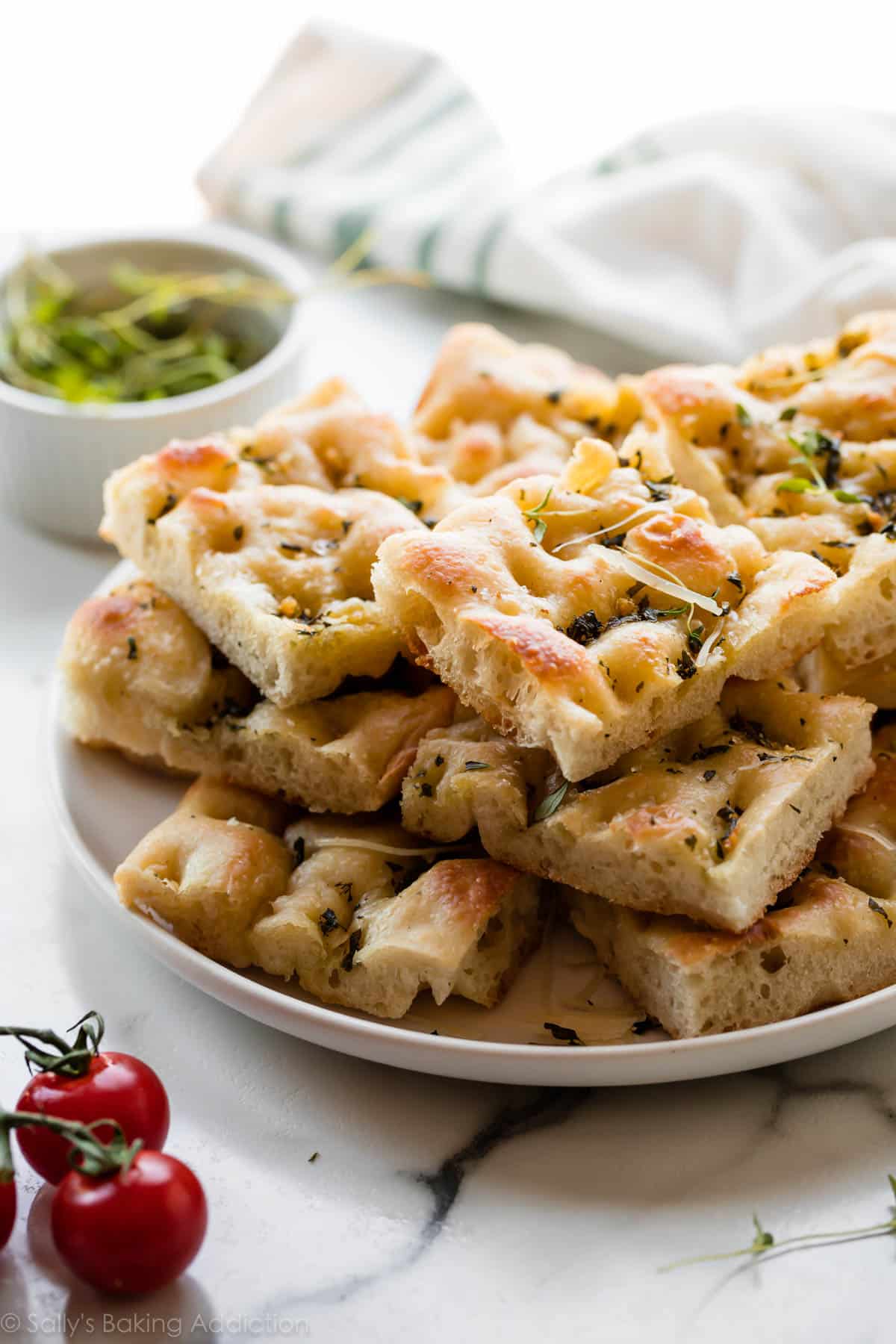
More Simple Homemade Bread
- Homemade Pizza Dough
- No Yeast Bread
- Soft Pretzels
- Garlic Knots
- Brown Butter Sage Dinner Rolls
- Artisan Bread
- Cornbread
- Olive Bread
- Whole Wheat Bread

Garlic Rosemary Herb Focaccia
- Prep Time: 16 hours
- Cook Time: 20 minutes
- Total Time: 16 hours, 20 minutes
- Yield: 2 dozen pieces
- Category: Appetizer
- Method: Baking
- Cuisine: Italian
Description
This simple 6-ingredient focaccia dough is a wonderful starting point for many different flavors, including this garlic rosemary herb focaccia. The homemade bread is chewy and soft in the center with a mega-crisp exterior. For the best flavor and texture, let the dough rest in the refrigerator overnight.
Ingredients
- 2 cups (480ml) warm water (between 100–110°F, 38–43°C)
- 2 teaspoons granulated sugar
- 2 teaspoons instant or active dry yeast (slightly less than 1 standard packet)
- 1/4 cup (60ml) extra virgin olive oil
- 1 Tablespoon kosher salt
- 4 and 1/2–5 cups (563–625g) all-purpose flour or bread flour (spooned & leveled), plus more for hands
Topping & Pan
- 5 Tablespoons (75ml) extra virgin olive oil or more as needed, divided
- 2 garlic cloves, minced
- 3–4 Tablespoons chopped fresh herbs such as basil, thyme, and rosemary (or 2 Tablespoons dried herbs)
- sprinkle of coarse salt and freshly ground black pepper
Instructions
- Prepare the dough: Whisk half of the water (1 cup; 240ml), 2 teaspoons sugar, and 2 teaspoons yeast together in the bowl of your stand mixer fitted with a dough hook or paddle attachment. Cover and allow to rest for 5 minutes.
- Add the remaining water, olive oil, salt, and 1 cup (130g) flour. Beat on low speed for 20 seconds, then add 3 and 1/2 cups (440g) more flour. Beat on low speed for 2 minutes. If the dough is still sticking to the sides of the bowl, add the last 1/2 cup (60g) of flour.
- Knead the dough: Keep the dough in the mixer and beat for an additional 5 full minutes, or knead by hand on a lightly floured surface for 5 full minutes. (If you’re new to bread-baking, my How to Knead Dough video tutorial can help here.) If the dough becomes too sticky during the kneading process, sprinkle 1 teaspoon of flour at a time on the dough or on the work surface/in the bowl to make a soft, slightly tacky dough. Do not add more flour than you need because you do not want a dry dough. After kneading, the dough should still feel a little soft. Poke it with your finger—if it slowly bounces back, your dough is ready to rise. You can also do a “windowpane test” to see if your dough has been kneaded long enough: tear off a small (roughly golfball-size) piece of dough and gently stretch it out until it’s thin enough for light to pass through it. Hold it up to a window or light. Does light pass through the stretched dough without the dough tearing first? If so, your dough has been kneaded long enough and is ready to rise. If not, keep kneading until it passes the windowpane test.
- Let the dough rise: Lightly grease a large bowl with a teaspoon of oil or some nonstick spray—just use the same bowl you used for the dough. Place the dough in the bowl, turning it to coat all sides in the oil. Cover the bowl with aluminum foil, plastic wrap, or a clean kitchen towel. Allow the dough to rise at room temperature for 2–3 hours or until double in size. (Tip: For the warm environment on a particularly cold day, heat your oven to 150°F (66°C). Turn the oven off, place the dough inside, and keep the door slightly ajar. This will be a warm environment for your dough to rise. After about 30 minutes, close the oven door to trap the air inside with the rising dough. When it’s doubled in size, remove from the oven.)
- Prepare the pan: Generously grease a 12×17-inch baking pan (with at least 1-inch-tall sides) with 2 Tablespoons of olive oil. This is the base layer of the bread, so be generous with the oil. A pastry brush is helpful to spread it.
- Flatten the dough: When the dough is ready, punch it down to release any air bubbles. Place on the oiled baking pan, then stretch and flatten the dough to fit the pan. Don’t tear the dough. If it’s shrinking (mine always does), cover it with a clean towel and let it rest for 5–10 minutes before continuing. This lets the gluten settle and it’s much easier to shape after that.
- Let the dough rest: Cover the dough tightly and let it rest in the refrigerator for at least 1 hour and up to 24 hours. The longer it rests, the better the flavor. I recommend at least 12 hours.
- Remove the dough from the refrigerator and let it sit at room temperature as you preheat the oven and prepare the toppings. Keep it covered. It may rise a little during this time, but not much.
- Preheat oven to 450°F (232°C). Allow it to heat for at least 10–15 minutes so every inch of the oven is very hot.
- Prepare the toppings: Whisk the 3 remaining Tablespoons of olive oil with the minced garlic and herbs. Set aside.
- Using your fingers, dimple the dough all over the surface. You can watch me do this in the video above. Drizzle on the olive oil topping and use your hands or a pastry brush to spread it all over the top. Add a little more olive oil if needed so the dough is completely covered. (This creates the crisp crust!) Sprinkle with a little coarse salt and freshly ground black pepper.
- Bake for 20–23 minutes or until lightly browned on top. If desired, broil on high for the last minute to really brown the top.
- Cut and serve hot or let it come to room temperature before slicing and serving. Focaccia tastes wonderful warm or at room temperature. Cover leftover focaccia tightly and store at room temperature for 2 days or in the refrigerator for 1 week. You can also freeze the baked and cooled focaccia for up to 3 months. Thaw in the refrigerator or at room temperature. To reheat the slices, you can use the microwave or bake in a 300°F (149°C) oven for 5 minutes.
Notes
- Freezing Instructions: After the dough rises, punch it down to release the air as instructed in step 5. Freeze the dough or portions of the dough to make at a later time. Lightly coat all sides of the dough ball(s) with olive oil. Place the dough ball(s) into individual zipped-top bag(s) and seal tightly, squeezing out all the air. Freeze for up to 3 months. To thaw, place the frozen dough in the refrigerator overnight. Remove the dough from the refrigerator and allow to rest for 30 minutes on the counter, then continue with shaping the dough to fit the baking pan as instructed in step 5. (Even after thawing, the dough must still rest in the refrigerator as instructed in step 6.)
- Make Ahead Instructions: The is a wonderful recipe to begin the day ahead of time. The dough must rest in the refrigerator for at least 1 hour and up to 24 hours, as instructed in step 6. I’ve let it go for as long as 30 hours and the flavor is incredible. I wouldn’t go past 24-30 hours.
- Special Tools (affiliate links): Stand Mixer | 12×17-inch Baking Pan | Pastry Brush
- Smaller Portions: This recipe yields a big pan of bread. You can divide the dough in half and bake smaller portions on 2 baking sheets or 9×13 inch baking pans. If desired, you can divide the dough in half and freeze half of it. Or you can halve the entire recipe.
- Yeast: You can use instant or active dry yeast instead. The rise time in step 3 may be a little quicker if using instant yeast. No matter which yeast you choose, you only need 2 teaspoons which is a little less than 1 standard 7g packet. Reference my Baking with Yeast Guide for answers to common yeast FAQs.
- Flour: You can use all-purpose flour or bread flour. All-purpose flour is convenient for most, but bread flour produces a chewier bread. No matter which you choose, the focaccia is still soft and rich with a crispy exterior. Either flour is fine and there are no other changes to the recipe if you use one or the other. You may need slightly closer to 5 cups of flour if using all-purpose.
Adapted from Bon Appetit & Pizza Crust





















I loved this recipe! I don’t have a lot of experience with breads, but it was well-written and the finished product was truly flavorful and fluffy, with a crisp exterior that was perfect for dipping in my puréed soup. Pretty foolproof for beginners. Thank you for sharing it!
I love the recipe but wondering what could be done to make the focaccia bread slightly taller that I could slice horizontally for sandwiches
Hi Nancy, you can use a 9×13 pan for thicker focaccia. We’re unsure of the exact bake time, but it will be longer. Keep a close eye on it — it’s done once lightly browned on top. Happy baking!
1st time making bread and everyone loves it! The bread went great with my stuff shells for dinner.
First off, I love this recipe! I am a Family and Consumer Sciences teacher and make this with my Foods students. The absolutely love it!
Another staff member makes sourdough focaccia bread and puts jelly and glaze on it. She said she adds sugar to the recipe for this. Could this recipe be used for that? How much sugar would you add?
Hi Sara, we’re so glad this is a favorite for you! We haven’t tested a sweet version of this focaccia, but it certainly sounds interesting. It would take a bit of testing, but you might look at some other sweet focaccia recipes to see how much sugar they add. It will take some trial and error. You will, of course, want to leave out the other savory herbs and spices here too. Let us know what you try!
Love love love all your recipes (especially your chocolate cake), but this was probably the most challenging one. I’ve made focaccia several times before using different recipes so thought I’d try this out as everything else I’ve tried has been perfect. I ended up having to use what felt like double the amount of flour for some reason, as the dough was very wet (almost like cake batter!), maybe I misread or mis-measured. I did use plain flour and saw the part about needing to use the larger volume of flour but I ended up using way way more. I potentially overprooved however, and only did an hour in the fridge. The focaccia was stunning and had an excellent crispy outside but the crumb was like that of a loaf cake or loaf of bread. It also smelled like a cake coming out of the oven! But it tasted amazing so it didn’t last long in my kitchen. Maybe I’ll try again 🙂
I made this today and would agree. I needed almost 50% more flour than the recipe called for. Even then, it was still quite sticky.
I made this when I had friends over for dinner and it was AMAZING. Such a simple recipe, but with fabulous results. So delicious and fun to make. Thank you.
Hi. I was wondering if it is ok to freeze the baked focaccia?
Hi Sandra, absolutely. You can freeze the baked and cooled focaccia for up to 3 months. Thaw in the refrigerator or at room temperature. To reheat the slices, you can use the microwave or bake in a 300°F (149°C) oven for 5 minutes.
I agree that something is off with the flour amount, and I weighed it too. I added WAY more flour than the recipe called for (cups!) and it was still a sticky mess. And at this very moment it is on it’s first rise, for 3 hours, and it turned back into a sticky mess, and no rising. SBA recipes are usually great – not this. It was such a mess (let alone disappointment), I won’t try again. Glad to see it’s not just me…
Hello Sally! First time making the focaccia this week. I am wondering if you could clarify the amount of olive oil specified for pan and topping? The ingredient list calls for 4 Tablespoons; the recipe says to use 2 Tablespoons for the pan and the “remaining” 3 Tablespoons for the topping. That adds up to 5 Tablespoons. I did separate the dough into two 9×13 pans but felt the 2 Tablespoons of oil was too much and it impeded the stretching out of the dough and I would likely use half that much in the future. That said, I welcome your clarification! Looking forward to dimpling and baking later today! – Gwen
Hi Gwen, I’m unsure how I missed your comment from over the summer! I just saw it now and can clarify. You need 1/4 cup of olive oil in the dough. Under “Topping & Pan” you need another 5 Tbsp (about 1/3 cup). 2 Tbsp for the pan (step 5) and 3 for the topping (step 10). You want a good amount of olive oil in the pan, because it helps form that crispy, chewy crust. I hope this helps clarify if you try the recipe again sometime!
Thanks so much for this recipe. My focaccia turned out very dry, dense and flat, as mentioned by others in the comments as well. Flavor was delicious though. Any idea what I may have done wrong? Thank you.
Hi MG, It could be that the dough was over proofed and/or over handled, causing it to lose some of the air pockets/bubbles. We recommend at least 12 hours in the refrigerator for best taste. Hope this helps and we’re so glad you enjoyed the bread! You may find it helpful to review our Baking with Yeast Guide, too.
Not sure what happened 🙁 I have loved every recipe I’ve tried in this site, but my focaccia turned out flat and dense. It’s edible at most. :/
Thank you posting this recipe, I used it as the base for focaccia bread art and won grand champion in an area baking contest.
Great recipe, thank you so much!! Is it also possible to keep the dough in the fridge for longer than 24 hours? For example 36 or 48 hours?
Hi Yasmin, we don’t recommend resting the dough more than 24-30 hours.
This was quite a production but oh my goodness, was it worth it. Even my husband who is not a bread lover really liked it. Even though I kept it in the refrigerator overnight it did raise quite a bit and after baking was about three inches thick. I will make this again and divide it into two to have a flatter bread. No problem eating two of this delicious bread.
Can you use pizza flour (oo) flour in this recipe?
Hi MaryAnn, That substitution shouldn’t be a problem here.
Every recipe I use from this content creator comes out perfect. This is my go to site.
Yay another awesome sally recipe! I made a few times but decided this time to do pizza. It’s fantastic! I added a bunch of herbs to the dough while it sat overnight in the fridge. Then this morning put a thin layer of sauce, cheese and oregano and extra garlic. Thank you so much for recipe and making things easier than they appear to be .
Hi! Thanks for the recipe 🙂 is it possible to substitute the extra virgin olive oil with regular olive oil?
I love all your recipes, especially the soft pretzels!
Thank you for your work!
Hi Chloe, that’s fine! Enjoy!
This came out deliciously! Though I had to use more flour than required b/c my dough was very wet, so not sure what I did wrong :/ I made sure to follow the recipe diligently. It still came out amazing! Will have to try again in the future.
Your focaccia recipe is great! A big hit with my family! Thanks for the helpful explanations as well!
Could you possibly give me the switches needed to make this into a black pepper fociccia bread? I love your recipes! My printer is going to run out of ink pretty soon! I know I can save them on the computer, but I am a paper and pencil girl.
Thanks Tara! I haven’t tested a black pepper version, but you could try adding 3/4 or 1 teaspoon freshly cracked black pepper (for lots of black pepper flavor) to the dough. Again, I have not tested this so let me know if you do!
What do you serve focaccia with? I was planning to serve it as an appetizer an will serve with a dipping oil, but not sure what else would compliment it?
Hi Shawneen, we love to enjoy focaccia just like that, with dipping oil. It also makes wonderful sandwiches.
This is a really good focaccia. We usually serve it as a light lunch or dinner with olives, cheese, proscuito, salami, pepperocini, etc. (and a glass of wine). Easy, delicious and no cooking!
We love this recipe! I put some seasonings on the top with the oil because I didn’t have herbs. The pan was on the center rack and the seasonings burnt. Any suggestions on preventing that?
Hi Jamie, for next time, you can either move the bread a rack down (away from the heating element), tent the pan with aluminum foil towards the end of bake time, or put the seasonings on closer to the end of bake time, so that they do not burn. So glad you enjoyed it!
I have been wanting to make Focaccia for some time. I’m excited to do it in the next few days. Would this be good as a base for pizza? (tomato sauce, mozzarella cheese, pepperoni) Or, should I still with Sally’s flatbread? My husband likes a thinner crust than my kids, so I thought this might be a good compromise for everyone.
Hi Deborah! We have seen focaccia topped with pizza toppings before, but have not tested it. Let us know if you do!
Sounds like you might want to make some detroit style pizza!
I didn’t expect to love this so much! It’s especially delicious fresh out of the oven… and still great at room temp. I’m freezing half of it (wrapped in foil then ziplock), so I’ll be curious to see how that is. I divided up the bread and topped different sections with different toppings… my fave was fresh, thinly sliced jalapeños. So good! I’d enjoy making this again and trying in a smaller pan for a thicker bread. It will be a fun one to play with! Oh… I wasn’t sure if the dough was supposed to fully come to room temp before baking… it was still chilled and baked perfectly golden in about 17 minutes.
I absolutely love this recipe, it’s my favourite!!! I use it so much!
The only question I have, is that I normally make this before bed and end up staying up for 2 hours before I fridge it.
Do you think this recipe would work if I fridge the dough immediately and then leave it to rise two hours on the side before I bake it?
I know that it needs to increase in size to be spread in the pan, but if I rise it to a place where it’ll fit in the pan and then complete the rise in the morning?
Hi Lauren, we’re so glad this is a favorite for you! You can let your dough rise overnight in the refrigerator. Cover it tightly in the bowl and place it in the refrigerator overnight. The next morning, remove it from the refrigerator and let it sit at room temperature for 1-2 hours, then continue with step 4.
This recipe has served me best of all the focaccia recipes I’ve tried! I’ve seen muffin versions of focaccia to make it more readily bite sized. Do you have any suggestions on how to adapt that from your recipe? I’m thinking of trying it out today where after refrigeration, I put it into a muffin tin and bake. My worry is that moving it from the pan after refrigeration might cause the dough to flatten again.
Hi John, we’re so glad you love this focaccia! We haven’t tried it in a muffin tin before so we’re unsure of the best bake time, but it should be a bit less. Keep a close eye on it, and please do let us know how it goes!
Love the recipe. How long to reheat and at what temp?
Hi Susan, To reheat the slices, you can use the microwave or bake in a 300°F (149°C) oven for 5 minutes.
Sally never misses!!!
Can I use half tablespoon table salt instead of the one tablespoon kosher salt?
Hi Mariam! We do prefer the flavor of Kosher salt here, but table salt will work in a pinch. We would use about 3/4 Tablespoon.